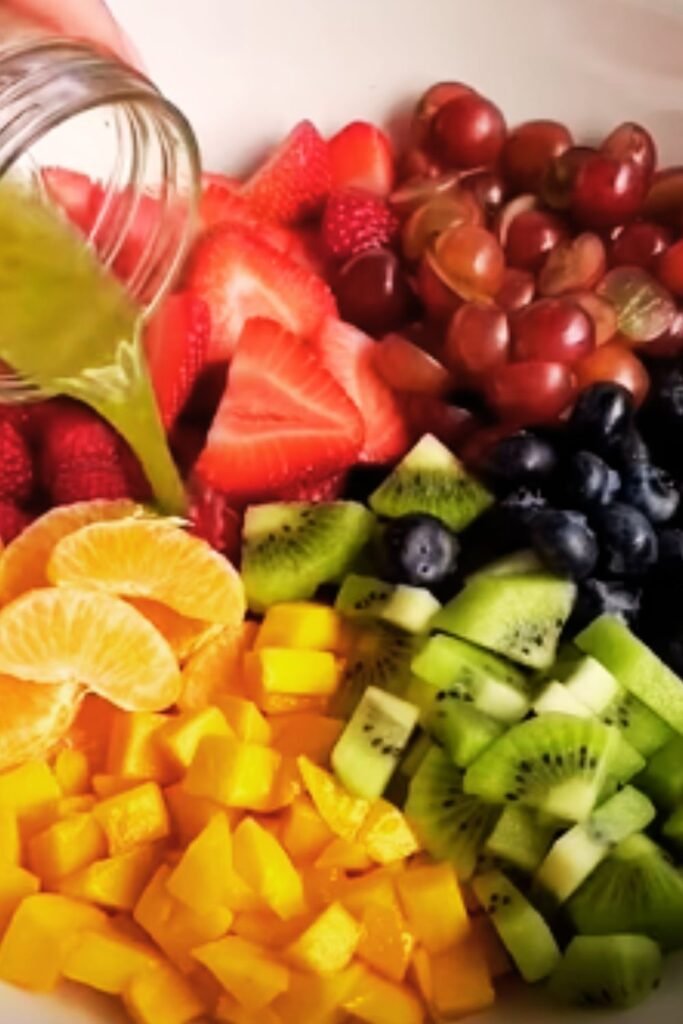There’s something magical about a perfect lemon vinaigrette that can transform even the simplest salad into something extraordinary. The bright acidity, the subtle hint of herbs, and that perfect balance of oil and acid come together to create a dressing that’s both refreshing and satisfying. I’ve spent years perfecting my lemon vinaigrette recipe, and today I’m thrilled to share all my secrets with you.
This isn’t just any dressing recipe—it’s a versatile kitchen staple that you’ll find yourself reaching for time and again. Whether drizzled over crisp greens, used as a marinade for chicken, or tossed with roasted vegetables, a good lemon vinaigrette brings a burst of sunshine to whatever it touches.
What Makes a Perfect Lemon Vinaigrette?
Before diving into the recipe, let’s talk about what makes a truly exceptional lemon vinaigrette. The perfect dressing strikes a delicate balance between:
- Acidity: The bright, tangy punch from fresh lemons
- Oil: The smooth, rich foundation that carries flavor
- Seasonings: The supporting cast of herbs, sweeteners, and aromatics
- Emulsification: That perfect, silky texture that coats your salad evenly
When these elements harmonize, magic happens. Too much acid and your dressing will make you pucker; too much oil and it becomes heavy and flat. But when balanced just right, a lemon vinaigrette lifts and enhances everything it touches.
Essential Ingredients

The beauty of a lemon vinaigrette lies in its simplicity. With just a handful of quality ingredients, you can create something truly spectacular. Here’s what you’ll need:
Core Ingredients:
- Fresh Lemons: Nothing compares to the bright, complex flavor of freshly squeezed lemon juice. Bottled juice simply won’t give you the same vibrant result. I recommend using organic lemons when possible, as you’ll be using the zest as well.
- Extra Virgin Olive Oil: This forms the base of your dressing. Choose a good quality oil with a flavor you enjoy—it doesn’t have to be the most expensive bottle, but it should taste good on its own.
- Dijon Mustard: Beyond adding a subtle tang, mustard acts as an emulsifier, helping your dressing stay mixed rather than separating.
- Honey or Maple Syrup: Just a touch adds balance and takes the edge off the lemon’s acidity without making the dressing sweet.
- Shallot or Garlic: These aromatics add depth and complexity. Shallots offer a milder, more elegant flavor, while garlic brings a more pronounced punch.
- Fresh Herbs: While optional, herbs like thyme, basil, or tarragon can elevate your dressing to new heights.
- Salt and Freshly Ground Black Pepper: These essential seasonings bring all the flavors into focus.
Optional Enhancements:
- Lemon Zest: For an intensified lemon flavor
- Greek Yogurt: For a creamier variation
- Parmesan Cheese: Adds savory depth
- Red Pepper Flakes: For a hint of heat
- Anchovy Paste: For umami richness (don’t worry, it won’t taste fishy!)
The Perfect Proportions
The classic vinaigrette ratio is 3 parts oil to 1 part acid, but I find that lemon vinaigrettes often benefit from a slightly higher proportion of acid. Here’s my preferred ratio:
| Ingredient | Quantity | Notes |
|---|---|---|
| Extra Virgin Olive Oil | 1/2 cup (120ml) | Use a good quality oil you enjoy the taste of |
| Fresh Lemon Juice | 3 tablespoons (45ml) | From approximately 1-2 lemons |
| Lemon Zest | 1 teaspoon | From an organic lemon |
| Dijon Mustard | 1 teaspoon | Smooth, not grainy |
| Honey or Maple Syrup | 1 teaspoon | Adjust to taste |
| Shallot | 1 tablespoon | Finely minced |
| Garlic | 1 small clove | Finely minced or pressed |
| Fresh Herbs | 1 tablespoon | Finely chopped (optional) |
| Salt | 1/4 teaspoon | Fine sea salt works best |
| Black Pepper | 1/8 teaspoon | Freshly ground |
This ratio creates a bright, flavorful dressing that’s still smooth and well-balanced. However, don’t be afraid to adjust according to your taste preferences—some people prefer a more lemony kick, while others might want a more mellow profile.
Step-by-Step Recipe
Now let’s put everything together:
- Prepare your lemons: Wash your lemons thoroughly, especially if using the zest. Using a microplane or fine grater, zest one lemon, being careful to avoid the bitter white pith. Then cut your lemons in half and juice them until you have 3 tablespoons of fresh juice. Strain out any seeds.
- Prepare your aromatics: Finely mince the shallot and garlic (if using). To reduce the raw bite, you can soak the minced shallot in the lemon juice for 5-10 minutes before continuing with the recipe.
- Combine base ingredients: In a bowl, whisk together the lemon juice, lemon zest, minced shallot, garlic, Dijon mustard, honey, salt, and pepper until well combined.
- Add the oil: While whisking constantly, slowly drizzle in the olive oil to create an emulsion. Alternatively, place all ingredients in a jar with a tight-fitting lid and shake vigorously until combined.
- Add herbs: Stir in any fresh herbs you’re using.
- Taste and adjust: This is the crucial step! Dip a lettuce leaf into the dressing and taste. Adjust seasonings as needed—perhaps a bit more salt, a touch more honey if it’s too tart, or a splash more lemon juice if it needs brightness.
- Let flavors meld: While you can use the dressing immediately, allowing it to sit for at least 30 minutes lets the flavors develop and meld beautifully.
Variations to Try
One of the joys of mastering a basic lemon vinaigrette is that it serves as a foundation for countless variations. Here are some of my favorite ways to customize:
Herb-Infused Lemon Vinaigrette
Add 2-3 tablespoons of finely chopped fresh herbs. Great options include:
- Basil for a Mediterranean flair
- Tarragon for an elegant French touch
- Dill for seafood salads
- Mint for a refreshing summer twist
- Thyme for earthy depth
Creamy Lemon Vinaigrette
Whisk in 2 tablespoons of Greek yogurt or crème fraîche for a luxurious, creamy texture that still maintains the bright lemon flavor.
Parmesan Lemon Vinaigrette
Add 2 tablespoons of finely grated Parmesan cheese for a savory umami boost that works beautifully with romaine lettuce (perfect for a healthier riff on Caesar salad).
Spicy Lemon Vinaigrette
Add 1/4 teaspoon of red pepper flakes or a small amount of minced jalapeño for a dressing with a kick.
Greek-Style Lemon Vinaigrette
Add 1/2 teaspoon dried oregano and 1 tablespoon crumbled feta cheese for a Mediterranean-inspired variation.
Storage Tips

A properly stored lemon vinaigrette can last for up to a week in the refrigerator, making it perfect for meal prep. Here’s how to store it properly:
- Container: Use a glass jar with a tight-fitting lid rather than plastic, as the acid in the lemon can react with some plastics.
- Refrigeration: Always store your dressing in the refrigerator between uses.
- Olive Oil Solidification: Don’t be alarmed if your dressing becomes cloudy or the oil solidifies somewhat in the refrigerator—this is normal! Simply remove the dressing 15-20 minutes before you plan to use it, and shake well to recombine.
- Shelf Life: For optimal flavor, use within 5-7 days. The garlic and fresh herbs will begin to lose their vibrancy after this time.
- Separation: Your dressing will naturally separate as it sits. This isn’t a sign that it’s gone bad—simply shake well before each use.
Serving Suggestions
One of the greatest virtues of a lemon vinaigrette is its versatility. Here are some of my favorite ways to use it:
Salads
- Simple Green Salad: Dress delicate spring greens or butter lettuce for a light starter
- Mediterranean Salad: Toss with romaine, cucumber, tomatoes, red onion, olives, and feta
- Grain Salad: Drizzle over a quinoa, farro, or bulgur wheat salad with roasted vegetables
- Bean Salad: Mix with chickpeas, white beans, or lentils for a protein-rich side
- Fruit Salad: Try a light drizzle over a salad of arugula, sliced apples, and walnuts
Beyond Salads

- Marinade: Use as a marinade for chicken, fish, or shrimp (20-30 minutes is perfect)
- Roasted Vegetables: Toss with vegetables after roasting for a bright finish
- Grain Bowls: Drizzle over buddha bowls or grain bowls
- Sandwich Spread: Brush on bread before building a sandwich for added flavor
- Dip: Serve as a dipping sauce for crusty bread or blanched vegetables
- Pasta Salad: Toss with cold pasta and summer vegetables for a refreshing side
Nutritional Benefits
Beyond its delicious flavor, lemon vinaigrette offers several nutritional benefits:
| Nutrient | Benefit |
|---|---|
| Vitamin C | Lemons provide immune-boosting vitamin C |
| Healthy Fats | Olive oil contains heart-healthy monounsaturated fats |
| Antioxidants | Both lemons and olive oil contain beneficial antioxidants |
| Low Sugar | Unlike many commercial dressings, homemade vinaigrette has minimal added sugar |
| Digestive Aid | Lemon juice can aid digestion and liver function |
By making your own vinaigrette, you also avoid the preservatives, excessive sodium, and artificial ingredients found in many store-bought dressings.
Troubleshooting Common Issues
Even experienced cooks sometimes run into challenges with vinaigrettes. Here’s how to solve common problems:
Too Tart
If your dressing makes you pucker, balance it with:
- A bit more honey or maple syrup
- A touch more olive oil
- A pinch of salt (which can actually reduce perceived acidity)
Too Oily
If your dressing tastes flat or greasy:
- Add more lemon juice
- Increase the mustard slightly
- Add a bit more salt to enhance flavors
Won’t Emulsify
If your dressing keeps separating:
- Add a bit more mustard, which acts as an emulsifier
- Ensure you’re adding the oil in a slow, steady stream while whisking
- Try blending with an immersion blender or regular blender for a more stable emulsion
Too Bland
If your dressing lacks punch:
- Add more salt and pepper
- Increase the lemon zest
- Add a minced garlic clove
- Consider adding a pinch of red pepper flakes
Replacing Store-Bought Dressings

Many commercial dressings contain ingredients you might prefer to avoid:
| Store-Bought Concerns | Homemade Advantages |
|---|---|
| Added sugars | Control sweetness level |
| Preservatives | Fresh, natural ingredients |
| Artificial flavors | Real lemon flavor |
| Low-quality oils | Choose your preferred quality olive oil |
| High sodium | Control salt content |
| Texture enhancers | Natural emulsification from mustard |
By making your own lemon vinaigrette, you control exactly what goes into your food, resulting in both superior flavor and nutritional profile.
Frequently Asked Questions
Q: Why does my vinaigrette separate so quickly?
A: This is natural! Oil and water (lemon juice) don’t want to stay mixed. For longer-lasting emulsification, make sure to use enough mustard and consider blending with an immersion blender. Even so, keep that jar handy for a quick shake before each use.
Q: Can I use bottled lemon juice in a pinch?
A: While fresh is always best, yes, you can substitute bottled lemon juice if necessary. Look for brands without preservatives, and consider adding a bit of extra zest to compensate for the fresher flavor you’ll be missing.
Q: How can I make my vinaigrette less acidic without adding sweetener?
A: Try using meyer lemons, which are naturally less acidic, or substitute part of the lemon juice with a milder acid like white wine vinegar. You can also simply increase the ratio of oil.
Q: Is it necessary to refrigerate lemon vinaigrette?
A: Yes, especially if it contains fresh ingredients like garlic, shallots, or herbs. Refrigeration extends shelf life and keeps these ingredients from spoiling.
Q: Can I use a different oil instead of olive oil?
A: Absolutely! While extra virgin olive oil provides a classic flavor, you can experiment with avocado oil for a neutral taste, walnut oil for a nutty profile, or even a bit of sesame oil (mixed with a neutral base oil) for an Asian-inspired variation.
Q: How can I make this dressing vegan?
A: Simply substitute the honey with maple syrup, agave nectar, or a touch of cane sugar. All other ingredients in the basic recipe are already plant-based.
Final Thoughts
A truly great lemon vinaigrette is more than just a salad dressing—it’s a culinary secret weapon that can elevate countless dishes with minimal effort. By mastering this simple recipe and understanding the principles behind it, you’re adding a versatile tool to your cooking repertoire.
What I love most about this dressing is how it brings a touch of brightness and sophistication to everyday meals. There’s something almost magical about the way good-quality olive oil and fresh lemon juice transform when combined with just the right supporting ingredients.
I encourage you to use this recipe as a starting point and then make it your own. Perhaps you’ll discover that you prefer a touch more garlic, or that a particular herb combination becomes your signature blend. The joy of cooking comes from this kind of personal exploration and discovery.
So grab some lemons, pull out your best olive oil, and get whisking! Your salads—and so much more—will thank you.


